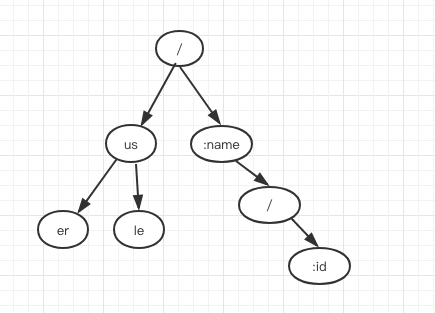gin的是路由算法其实就是一个Trie树(也就是前缀树). 有关数据结构的可以自己去网上找相关资料查看.
1.1.1. 注册路由预处理
我们在使用gin时通过下面的代码注册路由
1.1.2. 普通注册
router.POST("/somePost", func(context *gin.Context) {context.String(http.StatusOK, "some post")})
1.1.3. 使用中间件
router.Use(Logger())
1.1.4. 使用Group
v1 := router.Group("v1"){v1.POST("login", func(context *gin.Context) {context.String(http.StatusOK, "v1 login")})}
这些操作, 最终都会在反应到gin的路由树上
1.1.5. 具体实现
// routergroup.go:L72-77func (group *RouterGroup) handle(httpMethod, relativePath string, handlers HandlersChain) IRoutes {absolutePath := group.calculateAbsolutePath(relativePath) // <---handlers = group.combineHandlers(handlers) // <---group.engine.addRoute(httpMethod, absolutePath, handlers)return group.returnObj()}
在调用POST, GET, HEAD等路由HTTP相关函数时, 会调用handle函数
如果调用了中间件的话, 会调用下面函数
func (group *RouterGroup) Use(middleware ...HandlerFunc) IRoutes {group.Handlers = append(group.Handlers, middleware...)return group.returnObj()}
如果使用了Group的话, 会调用下面函数
func (group *RouterGroup) Group(relativePath string, handlers ...HandlerFunc) *RouterGroup {return &RouterGroup{Handlers: group.combineHandlers(handlers),basePath: group.calculateAbsolutePath(relativePath),engine: group.engine,}}
重点关注下面两个函数:
// routergroup.go:L208-217func (group *RouterGroup) combineHandlers(handlers HandlersChain) HandlersChain {finalSize := len(group.Handlers) + len(handlers)if finalSize >= int(abortIndex) {panic("too many handlers")}mergedHandlers := make(HandlersChain, finalSize)copy(mergedHandlers, group.Handlers)copy(mergedHandlers[len(group.Handlers):], handlers)return mergedHandlers}
func (group *RouterGroup) calculateAbsolutePath(relativePath string) string {return joinPaths(group.basePath, relativePath)}func joinPaths(absolutePath, relativePath string) string {if relativePath == "" {return absolutePath}finalPath := path.Join(absolutePath, relativePath)appendSlash := lastChar(relativePath) == '/' && lastChar(finalPath) != '/'if appendSlash {return finalPath + "/"}return finalPath}
在joinPaths函数里面有段代码, 很有意思, 我还以为是写错了. 主要是path.Join的用法.
finalPath := path.Join(absolutePath, relativePath)appendSlash := lastChar(relativePath) == '/' && lastChar(finalPath) != '/'
在当路由是/user/这种情况就满足了lastChar(relativePath) == ‘/‘ && lastChar(finalPath) != ‘/‘. 主要原因是path.Join(absolutePath, relativePath)之后, finalPath是user
综合来看, 在预处理阶段
1.在调用中间件的时候, 是将某个路由的handler处理函数和中间件的处理函数都放在了Handlers的数组中 2.在调用Group的时候, 是将路由的path上面拼上Group的值. 也就是/user/:name, 会变成v1/user:name
1.1.6. 真正注册
// routergroup.go:L72-77func (group *RouterGroup) handle(httpMethod, relativePath string, handlers HandlersChain) IRoutes {absolutePath := group.calculateAbsolutePath(relativePath) // <---handlers = group.combineHandlers(handlers) // <---group.engine.addRoute(httpMethod, absolutePath, handlers)return group.returnObj()}
调用group.engine.addRoute(httpMethod, absolutePath, handlers)将预处理阶段的结果注册到gin Engine的trees上
1.1.7. gin路由树简单介绍
gin的路由树算法是一棵前缀树. 不过并不是只有一颗树, 而是每种方法(POST, GET …)都有自己的一颗树
func (engine *Engine) addRoute(method, path string, handlers HandlersChain) {assert1(path[0] == '/', "path must begin with '/'")assert1(method != "", "HTTP method can not be empty")assert1(len(handlers) > 0, "there must be at least one handler")debugPrintRoute(method, path, handlers)root := engine.trees.get(method) // <-- 看这里if root == nil {root = new(node)engine.trees = append(engine.trees, methodTree{method: method, root: root})}root.addRoute(path, handlers)}
gin 路由最终的样子大概是下面的样子
type node struct {path stringindices stringchildren []*nodehandlers HandlersChainpriority uint32nType nodeTypemaxParams uint8wildChild bool}
其实gin的实现不像一个真正的树, children []*node所有的孩子都放在这个数组里面, 利用indices, priority变相实现一棵树
1.1.8. 获取路由handler
当服务端收到客户端的请求时, 根据path去trees匹配到相关的路由, 拿到相关的处理handlers
...t := engine.treesfor i, tl := 0, len(t); i < tl; i++ {if t[i].method != httpMethod {continue}root := t[i].root// Find route in treehandlers, params, tsr := root.getValue(path, c.Params, unescape) // 看这里if handlers != nil {c.handlers = handlersc.Params = paramsc.Next()c.writermem.WriteHeaderNow()return}if httpMethod != "CONNECT" && path != "/" {if tsr && engine.RedirectTrailingSlash {redirectTrailingSlash(c)return}if engine.RedirectFixedPath && redirectFixedPath(c, root, engine.RedirectFixedPath) {return}}break}...
主要在下面这个函数里面调用程序注册的路由处理函数
func (c *Context) Next() {c.index++for c.index < int8(len(c.handlers)) {c.handlers[c.index](c)c.index++}}

